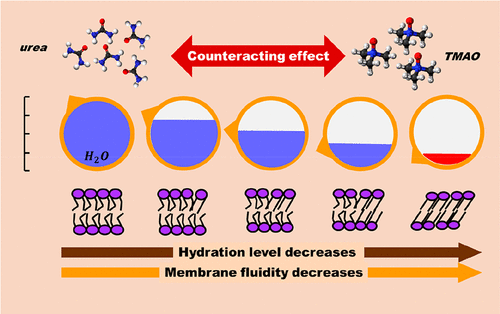当前位置:
X-MOL 学术
›
J. Phys. Chem. B
›
论文详情
Our official English website, www.x-mol.net, welcomes your feedback! (Note: you will need to create a separate account there.)
How Do Urea and Trimethylamine N-Oxide Influence the Dehydration-Induced Phase Transition of a Lipid Membrane?
The Journal of Physical Chemistry B ( IF 3.3 ) Pub Date : 2021-09-05 , DOI: 10.1021/acs.jpcb.1c05852 Archita Maiti 1 , Snehasis Daschakraborty 1
The Journal of Physical Chemistry B ( IF 3.3 ) Pub Date : 2021-09-05 , DOI: 10.1021/acs.jpcb.1c05852 Archita Maiti 1 , Snehasis Daschakraborty 1
Affiliation

|
Living organisms are often exposed to extreme dehydration, which is detrimental to the structure and function of the cell membrane. The lipid membrane undergoes fluid-to-gel phase transition due to dehydration and thus loses fluidity and functionality. To protect the fluid phase of the bilayer these organisms adopt several strategies. Enhanced production of small polar organic solutes (also called osmolytes) is one such strategy. Urea and trimethylamine N-oxide (TMAO) are two osmolytes found in different organisms combating osmotic stress. Previous experiments have found that both these osmolytes have strong effects on lipid membrane under different hydration conditions. Urea prevents the dehydration-induced phase transition of the lipid membrane by directly interacting with the lipids, while TMAO does not inhibit the phase transition. To provide atomistic insights, we have carried out all-atom molecular dynamics (MD) simulation of a lipid membrane under varying hydration levels and studied the effect of these osmolytes on different structural and dynamic properties of the membrane. This study suggests that urea significantly inhibits the dehydration-induced fluid-to-gel phase transition by strongly interacting with the lipid membrane via hydrogen bonds, which balances the reduced lipid hydration due to the decreasing water content. In contrast, TMAO is excluded from the membrane surface due to unfavorable interaction with the lipids. This induces further dehydration of the lipids which reinforces the fluid-to-gel phase transition. We have also studied the counteractive role of TMAO on the effect of urea on lipid membrane when both the osmolytes are present. TMAO draws some urea molecules out of the membrane and thereby reduces the effect of urea on the lipid membrane at lower hydration levels. This is similar to the counteraction of urea’s deleterious effects on protein by TMAO. All these observations are consistent with the experimental results and thus provide deep molecular insights into the role of these osmolytes in protecting the fluid phase of the membrane, the key survival strategy against osmotic-stress-induced dehydration.
中文翻译:

尿素和三甲胺 N-氧化物如何影响脂质膜的脱水诱导相变?
活生物体经常处于极度脱水状态,这对细胞膜的结构和功能是有害的。由于脱水,脂质膜经历流体到凝胶的相变,从而失去流动性和功能性。为了保护双层的流体相,这些生物体采用了几种策略。增强小极性有机溶质(也称为渗透剂)的生产就是这样一种策略。尿素和三甲胺N-氧化物 (TMAO) 是在不同生物体中发现的两种对抗渗透压的渗透剂。之前的实验发现,这两种渗透剂在不同的水化条件下对脂质膜都有很强的影响。尿素通过直接与脂质相互作用来防止脱水诱导的脂质膜相变,而 TMAO 不抑制相变。为了提供原子的见解,我们对不同水合水平下的脂质膜进行了全原子分子动力学 (MD) 模拟,并研究了这些渗透剂对膜的不同结构和动态特性的影响。这项研究表明,尿素通过氢键与脂质膜强烈相互作用,显着抑制了脱水诱导的流体到凝胶的相变,这平衡了由于水含量减少而减少的脂质水合作用。相反,由于与脂质的不利相互作用,TMAO 被排除在膜表面之外。这会导致脂质进一步脱水,从而加强流体到凝胶的相变。我们还研究了当两种渗透剂都存在时,TMAO 对尿素对脂质膜的影响的反作用。TMAO 将一些尿素分子从膜中吸出,从而降低尿素在较低水合水平下对脂质膜的影响。这类似于尿素的反作用 我们还研究了当两种渗透剂都存在时,TMAO 对尿素对脂质膜的影响的反作用。TMAO 将一些尿素分子从膜中吸出,从而降低尿素在较低水合水平下对脂质膜的影响。这类似于尿素的反作用 我们还研究了当两种渗透剂都存在时,TMAO 对尿素对脂质膜的影响的反作用。TMAO 将一些尿素分子从膜中吸出,从而降低尿素在较低水合水平下对脂质膜的影响。这类似于尿素的反作用TMAO对蛋白质的有害影响。所有这些观察结果都与实验结果一致,因此为这些渗透物在保护膜流体相中的作用提供了深入的分子见解,这是防止渗透应力诱导脱水的关键生存策略。
更新日期:2021-09-16
中文翻译:

尿素和三甲胺 N-氧化物如何影响脂质膜的脱水诱导相变?
活生物体经常处于极度脱水状态,这对细胞膜的结构和功能是有害的。由于脱水,脂质膜经历流体到凝胶的相变,从而失去流动性和功能性。为了保护双层的流体相,这些生物体采用了几种策略。增强小极性有机溶质(也称为渗透剂)的生产就是这样一种策略。尿素和三甲胺N-氧化物 (TMAO) 是在不同生物体中发现的两种对抗渗透压的渗透剂。之前的实验发现,这两种渗透剂在不同的水化条件下对脂质膜都有很强的影响。尿素通过直接与脂质相互作用来防止脱水诱导的脂质膜相变,而 TMAO 不抑制相变。为了提供原子的见解,我们对不同水合水平下的脂质膜进行了全原子分子动力学 (MD) 模拟,并研究了这些渗透剂对膜的不同结构和动态特性的影响。这项研究表明,尿素通过氢键与脂质膜强烈相互作用,显着抑制了脱水诱导的流体到凝胶的相变,这平衡了由于水含量减少而减少的脂质水合作用。相反,由于与脂质的不利相互作用,TMAO 被排除在膜表面之外。这会导致脂质进一步脱水,从而加强流体到凝胶的相变。我们还研究了当两种渗透剂都存在时,TMAO 对尿素对脂质膜的影响的反作用。TMAO 将一些尿素分子从膜中吸出,从而降低尿素在较低水合水平下对脂质膜的影响。这类似于尿素的反作用 我们还研究了当两种渗透剂都存在时,TMAO 对尿素对脂质膜的影响的反作用。TMAO 将一些尿素分子从膜中吸出,从而降低尿素在较低水合水平下对脂质膜的影响。这类似于尿素的反作用 我们还研究了当两种渗透剂都存在时,TMAO 对尿素对脂质膜的影响的反作用。TMAO 将一些尿素分子从膜中吸出,从而降低尿素在较低水合水平下对脂质膜的影响。这类似于尿素的反作用TMAO对蛋白质的有害影响。所有这些观察结果都与实验结果一致,因此为这些渗透物在保护膜流体相中的作用提供了深入的分子见解,这是防止渗透应力诱导脱水的关键生存策略。



























 京公网安备 11010802027423号
京公网安备 11010802027423号